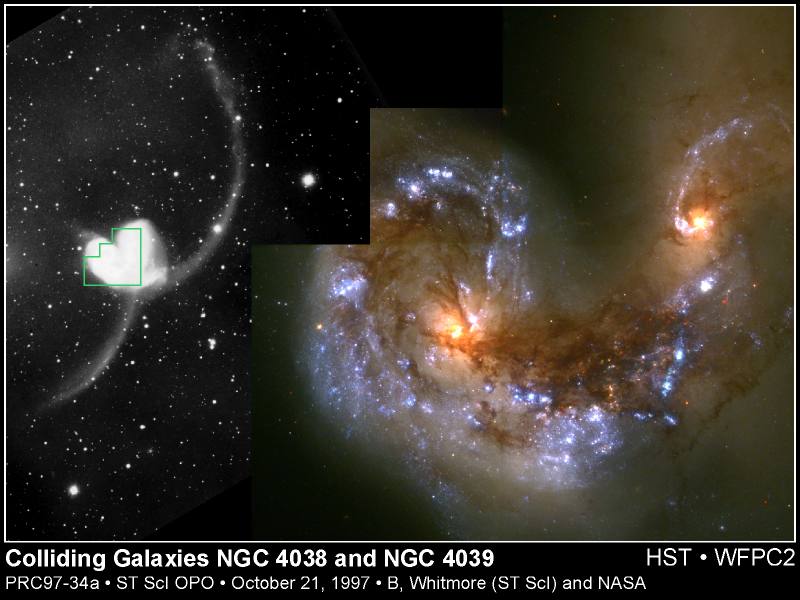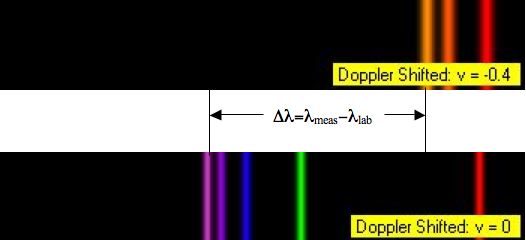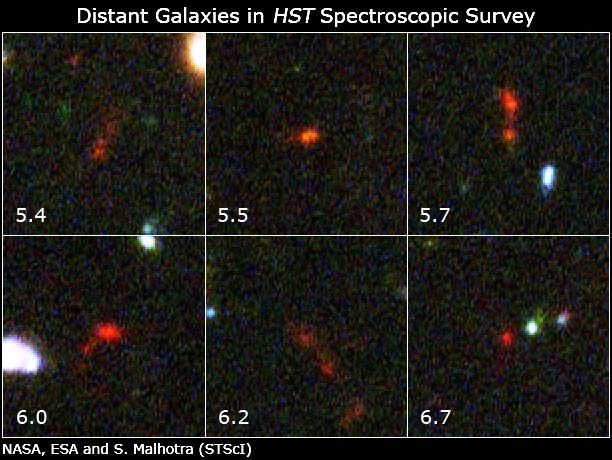CLEA - The Hubble Redshift Distance Relation
How do we know that the Universe is explanding? How can we know the age of the Universe?
Objective
 In this experiment, you will use a CLEA program to measure the speeds and distances to galaxies. By graphing the recessional speed vs. distance, you will measure the slope of the line which is the Hubble constant. The inverse of this constant can be used to calculate the age of the universe. In this experiment, you will use a CLEA program to measure the speeds and distances to galaxies. By graphing the recessional speed vs. distance, you will measure the slope of the line which is the Hubble constant. The inverse of this constant can be used to calculate the age of the universe.
Files
Background
When looking at galaxies, Edwin Hubble found that they were receding away from us. The implication was fairly obvious...perhaps the universe began at an instant in spacetime. Since then, spacetime itself has been expanding.
The rate of expansion, in units of km/s/Mpc (that's kilometers per second per megaparsec), is called the Hubble constant. It's an important constant because the inverse of this constant (i.e. 1 divided by the Hubble constant) is the age of the universe.
Note that all of the following videos were made by a good friend and great astronomer, Dr. Robert Knopp of Vanderbilt University.
 Get a long rubber band, scissors, a ruler, and a pen. Cut the rubber band and lay it out flat, unstretched. Use your ruler and pen to draw dots 1 cm apart on the rubber band until you have as many dots as possible across the length of the rubber band. Now, hold one end of the rubber band against the rulter so that it can't move. Grab the other end of the rubber band and stretch it until the first two dots are 2 cm apart. Using your ruler, measure the distance between each pair of dots. What do you notice? Get a long rubber band, scissors, a ruler, and a pen. Cut the rubber band and lay it out flat, unstretched. Use your ruler and pen to draw dots 1 cm apart on the rubber band until you have as many dots as possible across the length of the rubber band. Now, hold one end of the rubber band against the rulter so that it can't move. Grab the other end of the rubber band and stretch it until the first two dots are 2 cm apart. Using your ruler, measure the distance between each pair of dots. What do you notice?
 View the video reddots. In this video, you will view dots on a rubber sheet as the sheet is stretched. Notice that they all move farther apart from each other. View the video reddots. In this video, you will view dots on a rubber sheet as the sheet is stretched. Notice that they all move farther apart from each other.
 View the video expuniv2. In this video you will see an expanding balloon with galaxies painted on the balloon. This is a two-dimensional analogy of what is occurring in the four dimensional spacetime of our universe. But what you notice is that all galaxies are moving further away (i.e. receding) from all other galaxies. Every galaxy perceives itself to be the "center of the universe" because from each galaxy's perspective, all other galaxies are receding. You should also notice that further galaxies are receding faster. View the video expuniv2. In this video you will see an expanding balloon with galaxies painted on the balloon. This is a two-dimensional analogy of what is occurring in the four dimensional spacetime of our universe. But what you notice is that all galaxies are moving further away (i.e. receding) from all other galaxies. Every galaxy perceives itself to be the "center of the universe" because from each galaxy's perspective, all other galaxies are receding. You should also notice that further galaxies are receding faster.
Hubble discovered this by measuring the recessional speed of galaxies and found that the more distant galaxies are moving away from us at a greater speed.
But how did Hubble measure how fast galaxies were receding away from us?
 Now view the video cosmoz2. In this video you will see light traveling from one galaxy to the other as spacetime is expanding between galaxies. You will notice that due to the expansion, the wavelength of the light gets longer. Because red is the highest wavelength color of the visible spectrum, we say that the light is redshifted. Now view the video cosmoz2. In this video you will see light traveling from one galaxy to the other as spacetime is expanding between galaxies. You will notice that due to the expansion, the wavelength of the light gets longer. Because red is the highest wavelength color of the visible spectrum, we say that the light is redshifted.
The greater the redshift of light from a distant galaxy, the further the galaxy is away from us and the faster it is receding. The amount of redshift of a galaxy is proportional to its recessional speed. Thus, by measuring the amount of redshift of the galaxy, we can determine how fast it is receding.
Now, let me make a subtle but important point here. The galaxies are "receding away from us" not because of their motion but because spacetime itself is expanding between us. That's a very important point!
You see, galaxies can get close enough that they interact gravitationally. The gravitational forces of galaxies on each other can make them move toward one another, collide, or otherwise orbit one another.
The image below shows two galaxies colliding. Amazingly the probability of two stars actually colliding is very, very small. Most of a galaxy is empty space. But the gravitational pull on stars will affect the shape of the galaxies.

Galaxies in the Local Group, for example, are interacting. Our Local Group of galaxies is also interacting with a cluster of galaxies called the Virgo Cluster. (Read more about the Virgo Cluster.) Though spacetime is expanding between galaxies, the gravitational forces of galaxies on one another are also pulling them toward one another. Thus, they are interacting with each other within an expanding spacetime.
Motion due to interaction and motion due to the expansion of spacetime are two different ideas. In the videos you saw, there was no interaction between galaxies (because they were so far apart) so all perceived motion was due to the expansion of spacetime itself.
More on redshift of galaxies
When stars (or galaxies) are moving away from us, their spectral lines are shifted to lower frequencies, i.e. longer wavelength. Blue lines in a visible spectrum would be shifted closer to the red end of the visible spectrum. We then say that the spectrum is redshifted.
The bottom spectrum shown below is for hydrogen in the lab (where the speed of the object is v=0). The top spectrum is for hydrogen lines in a galaxy that is moving at four tenths of the speed of light away from us. As you can see, the lowest wavelength violet line gets shifted all the way up to the orange part of the spectrum.

The change in the wavelength of a spectral line, Δλ, is defined as the shifted wavelength minus the wavelength as measured in the laboratory. That is, it's the difference between the wavelength measured when the object is moving and the wavelength measured if the object were at rest.

The Greek letter Delta, Δ, stands for "change in" and the Greek letter lambda (λ) stands for wavelength. Thus, Δ&lambda is the change in the wavelength, or shift in the wavelength, of the spectral line, in this case due to the motion of the star or galaxy.
The redshift is the ratio of the change in the wavelength of a spectral line divided by its wavelength measured in the lab, and this is equal to the speed of the object (star or galaxy) divided by the speed of light.

Since nothing can travel faster than the speed of light, one would not expect the redshift to be greater than 1. However, we do measure redshifts of galaxies to be greater than 1. Does this mean that the galaxies are traveling faster than the speed of light? No way! The equation written above is an approximation and only works for objects moving much less than the speed of light. As the object's speed gets closer to the speed of light, we have to use Einstein's theory of special relativity to derive a relativistically correct equation for redshift. You can sign up for PHY 321 (Modern Physics) to learn how to derive this equation. The relativistically correct Doppler shift, as determined from Einstein's special relativity, is

Using this equation, as recessional speeds get closer to the speed of light, the calculated redshift can be greater than 1.
The shift in wavelength of spectral lines for galaxies can be enormous due to the very high recessional speeds of galaxies due to the expansion of the universe. The Hubble redshift-distance relation shows that the most distant galaxies are the ones traveling the fastest. Measuring the redshift of a galaxy thus gives us an idea of how far away it is.
Check out the redshifts of these galaxies measured with the Hubble Space Telescope. The galaxies even appear red due to the enormous redshift of their light. These are some of the furthest galaxies ever measured. The light from these galaxies left about 13 billion years ago, 1-2 billion years after the creation of the universe. The numbers shown in the images are the redshifts of the galaxies. The highest redshift is for the furthest galaxy.

Procedure
We will use the CLEA program called The Hubble Redshift Distance Relation. You should have already installed it.
1. Download two files: (1) the handout and (2) a spreadsheet for doing the calculations.
2. Watch the following instructional video that will help you understand how to use the software.
 hubble.mov. This part shows you how to measure the distance and recessional speed of a galaxy. hubble.mov. This part shows you how to measure the distance and recessional speed of a galaxy.
3. Make the measurements described in the handout and enter your data in the spreadsheet. The green boxes are where you type your data and the purple box is a calculation.

|